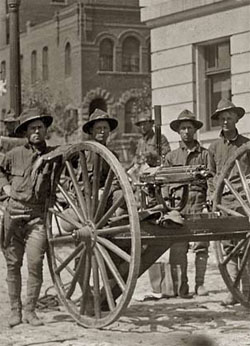Montana: Stories of the Land
Companion Website and Online Teacher's Guide
Chapter 16 - Montana and World War I, 1914-1918
Chapter 1 - Montana: Where the Land Writes History
Chapter 2 - People of the Dog Days
Chapter 3 - From Dog Days to Horse Warriors
Chapter 4 - Newcomers Explore the Region
Chapter 5 - Beaver, Bison, and Black Robes
Chapter 6 - Montana's Gold and Silver Boom
Chapter 7 - Two Worlds Collide
Chapter 8 - Livestock and the Open Range
Chapter 9 - Railroads Link Montana to the Nation
Chapter 10 - Politics and the Copper Kings
Chapter 11 - The Early Reservation Years
Chapter 12 - Logging in the "High Lonesome"
Chapter 13 - Homesteading This Dry Land
Chapter 14 - Towns Have Lives, Too
Chapter 15 - Progressive Montana
Chapter 16 - Montana and World War I
Chapter 17 - Montanans on the Move
Chapter 18 - The Great Depression Transforms Montana
Chapter 19 - World War II in Montana
Chapter 20 - Building a New Montana
Chapter 21 - A People's Constitution
Chapter 22 - Living in a New Montana
Learning From Historical Documents
Letter to Charles Greenfield, State Defense Committee, from Terry, MT. 1918. Montana Council of Defense records, 1916-1921. Record Series 19 . [box 2 folder 22]. Montana Historical Society Research Center. Archives.
Context for Charles Greenfield's Letter:
In 1917 American entry into World War I led to an extreme nationalism that would have been humorous had it not been so destructive of individual liberties. The Montana Council of Defense, authorized by federal directives to root out pro-German sentiments on the local level, proved to be one of the most zealous such organizations in the nation. The Montana Sedition Act of 1918 served as a model for similar federal legislation. By the winter of 1917-18 the state was so well organized that even the smallest community had its local council and the public, generally favorable to the growing disregard for civil rights, had learned to be alert for the enemies within.
About Primary Sources:
Letters, diary entries, census records, newspapers, and photographs are all examples of "primary sources," material created at a particular moment in the past that has survived into the present. Primary sources can provide clues to the past. They are our windows into an earlier time. The Montana Historical Society contains thousands of primary sources. The above item from the Society's collection relates directly to this chapter.


